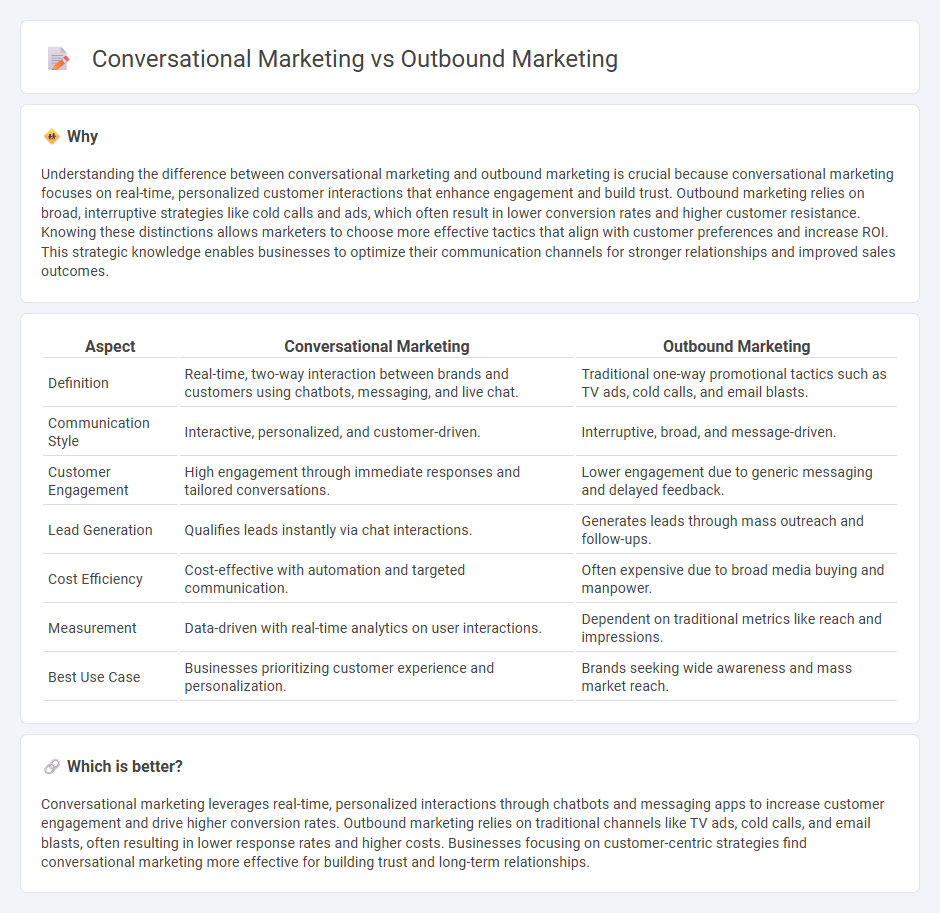
Conversational marketing leverages real-time, personalized interactions through chatbots and messaging platforms to engage customers, fostering immediate feedback and higher conversion rates. Outbound marketing relies on broad, interruptive tactics like cold calls, direct mail, and traditional advertisements to reach potential clients. Explore the key differences and advantages of both strategies to optimize your marketing approach.
Why it is important
Understanding the difference between conversational marketing and outbound marketing is crucial because conversational marketing focuses on real-time, personalized customer interactions that enhance engagement and build trust. Outbound marketing relies on broad, interruptive strategies like cold calls and ads, which often result in lower conversion rates and higher customer resistance. Knowing these distinctions allows marketers to choose more effective tactics that align with customer preferences and increase ROI. This strategic knowledge enables businesses to optimize their communication channels for stronger relationships and improved sales outcomes.
Comparison Table
| Aspect | Conversational Marketing | Outbound Marketing |
|---|---|---|
| Definition | Real-time, two-way interaction between brands and customers using chatbots, messaging, and live chat. | Traditional one-way promotional tactics such as TV ads, cold calls, and email blasts. |
| Communication Style | Interactive, personalized, and customer-driven. | Interruptive, broad, and message-driven. |
| Customer Engagement | High engagement through immediate responses and tailored conversations. | Lower engagement due to generic messaging and delayed feedback. |
| Lead Generation | Qualifies leads instantly via chat interactions. | Generates leads through mass outreach and follow-ups. |
| Cost Efficiency | Cost-effective with automation and targeted communication. | Often expensive due to broad media buying and manpower. |
| Measurement | Data-driven with real-time analytics on user interactions. | Dependent on traditional metrics like reach and impressions. |
| Best Use Case | Businesses prioritizing customer experience and personalization. | Brands seeking wide awareness and mass market reach. |
Which is better?
Conversational marketing leverages real-time, personalized interactions through chatbots and messaging apps to increase customer engagement and drive higher conversion rates. Outbound marketing relies on traditional channels like TV ads, cold calls, and email blasts, often resulting in lower response rates and higher costs. Businesses focusing on customer-centric strategies find conversational marketing more effective for building trust and long-term relationships.
Connection
Conversational marketing leverages real-time, personalized interactions to engage prospects, which complements outbound marketing strategies by nurturing leads generated through targeted outreach campaigns. By integrating chatbots and messaging platforms, businesses can enhance the effectiveness of outbound efforts, ensuring higher conversion rates and improved customer experiences. This synergy creates a dynamic marketing funnel that drives engagement and accelerates sales cycles.
Key Terms
Cold Calling
Cold calling in outbound marketing relies on proactive outreach through unsolicited phone calls to generate leads and promote products or services. Conversational marketing integrates real-time, personalized interactions using chatbots or live agents to engage prospects and qualify leads more efficiently. Discover how blending these strategies can transform your lead generation efforts and boost conversion rates.
Lead Nurturing
Outbound marketing relies heavily on broad-reaching tactics like cold calls, emails, and ads to generate leads, often resulting in lower engagement and slower lead nurturing. Conversational marketing employs personalized, real-time interactions via chatbots, live chat, and messaging apps, enhancing lead nurturing by fostering immediate, meaningful dialogue that accelerates decision-making. Explore how integrating conversational marketing can transform your lead nurturing strategies for higher conversion rates.
Engagement
Outbound marketing relies on broad messaging through channels such as TV, radio, and email blasts to reach wide audiences, often lacking personalized interaction. Conversational marketing employs targeted, real-time communication via chatbots, social media, and live chat, fostering deeper engagement by addressing individual customer needs and preferences. Explore the benefits of conversational marketing to enhance your customer relationships and boost engagement rates.
Source and External Links
Outbound Marketing Examples To Grow Brand Awareness & Pipeline - Outbound marketing is a method to reach and engage potential customers before interest has been established, using tactics like cold emails, TV ads, and billboards to build brand awareness and sales pipeline.
What Is Outbound Marketing? - WordStream - Outbound marketing is any marketing where a company initiates contact with an audience through traditional forms such as TV commercials, cold calls, print ads, and outbound sales calls, generally harder to track and less profitable than inbound marketing.
Inbound Vs Outbound Marketing: What is the Difference? - Outbrain - Outbound marketing relies on buying ads and acquiring email lists to maximize brand exposure, appealing especially to non-digital native segments and playing a key role in omnichannel marketing strategies.
 dowidth.com
dowidth.com